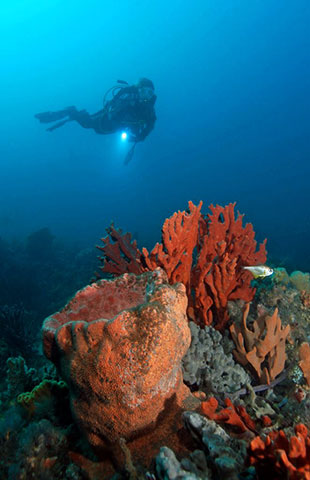
SCUBA diving and snorkelling

The park is renowned for SCUBA diving and snorkelling.
- Fly Point is home to some of the east coast's most extensive sponge gardens, which attract a wide variety of marine fish and invertebrates. Fly Point's long-term protection as a marine sanctuary zone (protected from fishing since 1983) has allowed fish and sea creatures to thrive. It is the safest place to snorkel in Port Stephens. The best time to snorkel and dive is at the top of the high tide.
- Halifax Park is home to blue gropers and crimson banded wrasse. Look among the rocky crevices and you might spot a wobbegong shark. It is important to snorkel and dive at Halifax Park around the top of the high tide. Take care when snorkelling and diving as many boats pass through the area.
- Shoal Bay has extensive seagrass meadows. Snorkel over the seagrass and see how many species call it home. It's a great place to find cuttlefish, seahorses and pipefish, and over summer, large flathead hide out, waiting for prey.
- Boat Harbour and Fisherman's Bay are on the ocean side of Port Stephens (near Anna Bay). The bottom terrain of rocky and kelp covered reef are great places to see a variety of fish, such as wrasses, bream and morwongs. You might even come across a sea turtle or the protected black rockcod.
The offshore islands are renowned diving destinations and local dive boats visit them daily.
- Broughton Island has resident grey nurse sharks. The Looking Glass is a spectacular spot when the sun is shining and the water is clear. Looking Glass also has resident blue devilfish and some elusive weedy seadragons. The island's North Rock has extensive sponge gardens below 18 m where the protected elegant wrasse can be found.
- At Cabbage Tree Island, the Little Wreck is protected from winds and swells. The remains of two old boats attract wobbegongs, flathead and blue gropers. Other prime sites include the SS Oakland wreck, Boondelbah and Little Island.
- The Pipeline was rated one of the world's best shore dives in 2009. Unusual species such as the thorny seahorse, the blue ringed octopus and the elusive Nelson Bay anglerfish are often spotted. The best area to find marine critters is between the pipe and the break wall among the sponges and soft-corals at 7-9 m deep.
Tour operators offer snorkelling tours and SCUBA diving tours and training most days. For more visitor information visit the Destination NSW website.
What you need to know
The Pinnacle, Big Seal and Little Seal at Seal Rocks, and Little Broughton Island are declared grey nurse shark critical habitats. Special rules to protect these sharks apply.
Please refer to the NSW Department of Primary Industries and Regional Development for a list of prohibited activities in critical habitat areas and a code of conduct that applies in all sites where grey nurse sharks occur.

